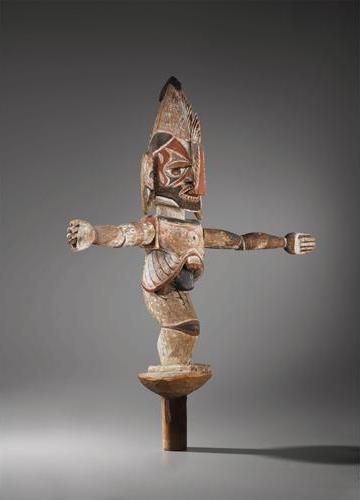 Sotheby's Paris, 2010, Rosenthal Sale.
Sotheby's Paris, 2010, Rosenthal Sale.
 Sotheby's Paris, 2010, Rosenthal Sale.
Sotheby's Paris, 2010, Rosenthal Sale.
PARIS, March 24, 1600, galerie Charpentier, facing the Palais de l'Elysee. A small crowd of journalist is waiting on the pavement for announcements from the governement. They are paying no attention to the people heading to Sothebys. In contrast with the bi annual sales held in June and December, only about 60 people are present today for a sale of the Rosenthal collection of oceanic art. Of course, we see the known faces of Paris oceanic art and surprisingly only a few Parisian dealers. 38 lots from Rosenthal collection are going to be auctionned, important artifacts from New Ireland, polynesia and Massim. There was also several rather poor new guinea artifacts and it is pretty clear that without the rosenthal provenance they would have been rejected by any auction house.
Cyril cohen was holding the hammer and led the auction. Few action from people in the room, most of the bidding was done on the phone, in particular for the most expensive items. I noted that the most expensive item sold in the room was the New Ireland Kipong mask (lot 6) for 79 000 euros.
The Vlamink one legged Malagan (lot 7) fetched 240 000 euros while the Uli (lot 4) did 114 000 euros. Two excellent new ireland pieces with strong provenances. These two had been bought at the Vérité sale, and sold for about 20-30 % less than their 2006 prices. I actually remember the Uli sale in 2006 where actually de Montbrison was bidding... most likely on behalf of the Rosenthal.
My favorite was the Malagan collected by Hans Meyer and formerly from Solvit collection (lot 8) sold for 156 000 euros. I view it as the archetype of a very nice end of XIXcentury Malagan figure. In 1998, only 120 000 francs (18 000 euros) had been needed to acquire such an exquisite piece. This is a perfect illustration of the developpement of the oceanic art market over the last 10 years.
The very large and superb hei tiki (lot 11) has been the cause of a strong battle over the phone, ending at 372 000 euros. The massive proportion and subtility in the carving was evident when seeing the carving in the flesh, giving a stronger impression than the reproduction in the catalogue. It was more surprising was to see the moai Kavakava (lot 12 ) also reaching 372 000 euros. Good provenance, but what was more disturbing was the patina that seemed to have evolved since the christies 1988 auction catalogue...
Massim spatulas : several spatulas bought from Meyer by the rosenthal did very well. A special notice to the one with Mutuaga provenance that reached 51 000 euros. Mutuaga is one of the rare artists from XIX cent New Guinea who lost his anonimous status thanks to the work of Harry Beran. About 30 artifacts properly identified are known today, this spatula being one of the older ones. I would remark that none of these spatula showed the caracteristics traces of use on the blade, but it does not prevent bidders to reach 10 000-15 000 euros.
The New guinea material bought in 1970 in Tahiti was very disapointing. I did not understand the presence of these artifacts next to master pieces like the Malagans or the Hei tiki. In my opinion, labelled with this 1970 provenannce, there was one interesting artifact, the Huon gulf cup (lot 25). Not surprisingly it was picked up by an important French tribal art dealer. However, the mortars (18, 20, 21), pestle and the yipwon were absolutely not at all my taste. The Boiken shell money (28), or the rather poor shouten island mask (32) not surprisingly didn't sell, and then ended up in a Parisian gallery few month later. However, there has been a fierce battle for two arawe shields from New britain until 19500 euros for a (rightfully low) estimate of 1500-2500. I could not understand that such prices would be reached for 1950s metal carved with trade paint danse shields from New Britain.
The yipwon was having a thick black patina and a carving that would be 1960s style. Almost 14 000 euros... Such a poor artifact was fortunately eclipsed by the superb Canak roof final that ended the sale at 31 000 euros.
At the end of the sale, I got a mixed feeling. How it comes that such master pieces could be lined up with artifacts that would be difficult to sell even on ebay ? It is reminding us that all collectors are doing mistakes and that we should get rid of these mistakes instead of lining them with the best artifacts. The good news is that some master pieces are still around !
JPB.